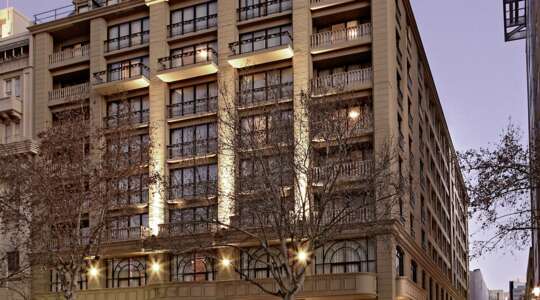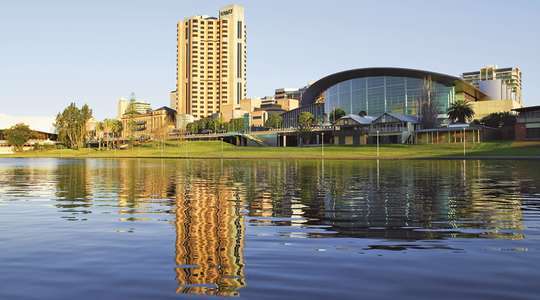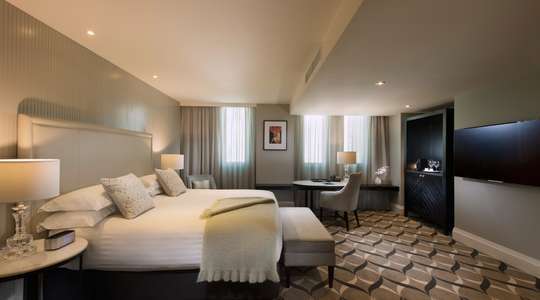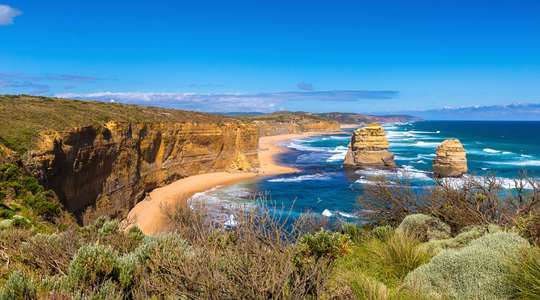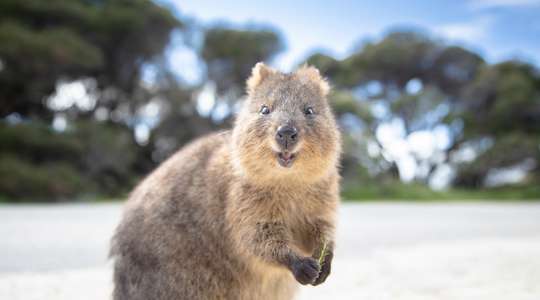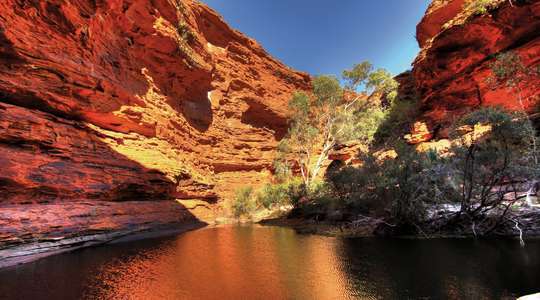- 0800 092 4444
- Search
- My Kuoni
Speak to one of our experts now about this offer
Call us on - 0800 092 4444
Or drop into your local Kuoni store to find out more
Speak to one of our experts now about this offer
Call us on - 0800 294 9710
Or drop into your local Kuoni store to find out more
Speak to one of our experts now about this offer
Call us on - 0800 294 9728
Or drop into your local Kuoni store to find out more
Adelaide Holidays
A charming and cosmopolitan city with a rich history, Adelaide is a cultured destination in its own right and an ideal jumping-off point for wildlife adventures and vineyard discoveries.
Whether you fly into Adelaide or arrive after a drive on the Great Ocean Road, this small city is a great hub for exploring South Australia’s wineries and wild natural highlights like Kangaroo Island and the Flinders Ranges. The city can also be the start or end of an epic overland train journey on The Ghan or the Indian Pacific.
Adelaide is known as the ’20-minute city’ because its compact size makes it so easy to get around quickly. This friendly metropolis is part of the UNESCO Creative Cities Network, so you’ll find a never-ending list of live music, performing arts and festivals going on. Adelaide is less frenetic than Sydney and Melbourne, but also has those typical sandy beaches that stretch over 20 miles right on the city’s doorstep.
Read moreAdelaide Hotels
Our recommendations for the best places to stay in Adelaide
Holidays in Adelaide
You may also like
Get to know Adelaide and those important practicalities when planning your perfect holiday.
GMT +8½ hours
Australian Dollar
Adelaide: 19.5 hours (not including stopover time)
Majority Christian
Australia has no official language but the majority of people speak English as their first language. Approximately 250 indigenous Australia languages are spoken.
Where is Adelaide?
Adelaide, the capital of South Australia, lies on a plain between Gulf St Vincent and the mountains in the state’s south-east corner. The original British settlement was established around five miles inland on the banks of the River Torrens, but its metropolitan area now stretches for 60 miles along the coast and to the foothills of the Mount Lofty Ranges. Its international airport, a convenient 15-minute drive from town, has regular services to other Australian capitals and further-flung destinations. Railway buffs have various options, including The Ghan from Adelaide to Darwin via Alice Springs and the Indian Pacific between Perth, Adelaide and Sydney. The Great Ocean Road, meanwhile, provides a scenic self-drive route to Melbourne.
Central city
Adelaide’s belatedly listed historic centre was the vision of one man, Colonel William Light, who wanted to create somewhere that reflected its status as one of the country’s first free settlements. Its elegant 1830s design – a riverside grid of streets, squares and boulevards wrapped in parkland – gives the area an indelible charm, enhanced by fine 19th-century sandstone buildings that sprung up as the new town began to thrive. You could spend several days exploring this area alone. The fringing park is home to Adelaide’s lush Botanic Garden, the conservation-focused zoo and the iconic Adelaide Oval cricket ground, while North Terrace is the city’s cultured boulevard where you’ll find several major galleries and museums.
Waterfront city
When Adelaide was founded, its coastal dunes were regarded largely as useful protection from the sea. A century later, the almost-uninterrupted 20 miles of sandy beaches on the doorstep had acquired a new appeal and the city began to unfold westwards to the sea. Nowadays, Adelaide’s coastal suburbs are some of its most desirable, with chic shopping centres, excellent places to eat and a dash of culture. A tram ride from the centre, Glenelg has a family-friendly stretch of sand, indie boutiques and bars for sunset drinks. Henley Beach is a little more grown-up and peaceful, so you won’t have a problem finding a quiet spot on the sand; there are some excellent restaurants, too.
Getting around
Walking is the best way to explore the compact centre, where there’s something new to see around every corner and plenty of shady spots and inviting cafés when you need a break. If you’re slightly more intent on getting from A to B or just have further to travel, cycling is an enjoyable alternative, while buses, trams and trains allow you to zip to all parts in comfort – the 40-minute tram ride to the seaside at Glenelg is definitely one to add to your itinerary. To see the city from a different perspective, take a trip by kayak or a leisurely cruise along the River Torrens.
Eating & drinking
Eating out is one of the joys of visiting Adelaide, whether you’re into dressed-up fine dining or something quirkier. Start your foodie journey at Adelaide Central Market, which opened in 1869; stalls heaped with superb local and speciality products sit cheek-by-jowl with those serving up mouthwatering global street food. Next door, you can’t miss the red gates at the entrance to Chinatown, while the streets beyond are liberally studded with characterful cafés, authentic pizzerias and small eateries serving inventive Australian cuisine. There’s more to whet your appetite beyond the town centre, especially on the coast; Henley is known for its upmarket seafood restaurants, while Brighton has a more laidback, eclectic dining scene.
Arts & culture
This UNESCO Creative City has a thriving performing arts and music scene to go with its rich cultural heritage. If there isn’t a festival devoted to theatre, world-music or comedy in progress – which there often is – there are self-guided architectural tours through the historic centre, street art from yarnbombing to murals wherever you go, and anything from live acoustic sets in pubs to operas at the beach air. Along what’s called the North Terrace Cultural Precinct, you can plunge into the state’s history at a trio of institutions: the South Australian Museum, the State Library and the Migration Museum. The porticoed Art Gallery of South Australia is also here, featuring a collection of more than 45,000 works spanning two millennia.
Gardens
Green open spaces were hardwired into the layout of the city from its beginning, thanks to its border of parkland. A haven within that haven, the 123-acre Adelaide Botanic Garden is more than just a repository of plants from across Australia and beyond. Between exploring towering forests of native trees, wetlands and rose gardens, you can admire the architecture of the Palm House dating from 1877 and the startlingly modern design of the Waterlily Pavilion – or just find a shady spot for a picnic bought from the nearby Central Market. There’s an unexpected treasure in the southern section of the parklands: a serene Japanese-style sanctuary with a dry garden and a lakes-and-mountain garden created in the 1980s.
Adelaide Hills
Just beyond the city’s eastern fringes in the Mount Lofty Ranges. the Adelaide Hills is the archetypal leafy retreat. Go birdwatching along wooded trails in search of paint-palette rosellas, lorikeets and cockatoos, go church-hopping through fairytale villages founded by Lutheran German settlers and linger over fabulous meals in one of the area’s destination restaurants. It’s also a wine region, unique in South Australia for producing superb cool-climate classics thanks to its elevated position. Oenophiles will certainly want to visit one of the award-winning wineries for a vineyard wander, cellar tour and personalised tasting of sparkling pinot noirs and crisp sauvignon blancs.
Adelaide Weather
Sep - Apr
January
February
March
April
May
June
July
August
September
October
November
December
Adelaide Weather by Month
Sorry, your hotel is no longer available
Please check alternatives
-
{{item.body}}
-
{{item.body}}
Choose a departure date
{{store.searchDuration}} nights
Enter rooms & guests
Checking prices & availability

{{term}}, {{formattedDate}} for {{searchDuration}} nights
Destinations See all Destinations
HolidaysSee all Holidays
OffersSee all Offers
InspirationSee all inspiration
We're transferring you to our tailor-made specialists
 |  |  |
From the multi-award-winning Kuoni
_w=83_h=42.png?v=931108ac3c61e45b9dc1b2284a500ac70c03b561)
_w=161_h=19.png?v=931108ac3c61e45b9dc1b2284a500ac70c03b561)
